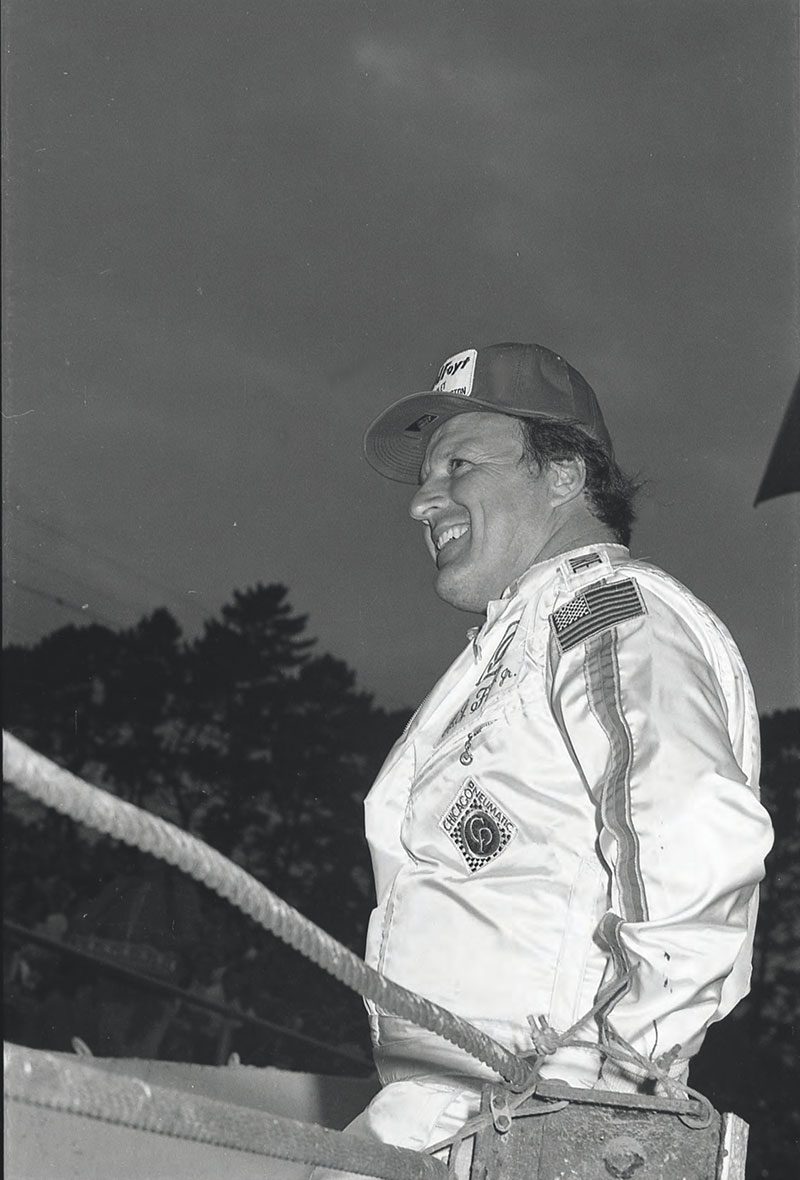When God raced in paradise
In many ways, the racing appearances of legendary American racer AJ Foyt in New Zealand signalled the undeniable possibilities that were sitting waiting for midget car racing in New Zealand. Still, it’s a piece of history rapidly slipping into the sport’s folklore.
It all came at a time when motorsport was riding the crest of a wave, with the annual Tasman Series for Formula 5000’s commanding a considerable amount of ink, not only in trade I magazines but also in the daily papers, radio stations and television channels, who all clamoured for a ‘scoop’.
There were often stories circulating that world-class drivers like Mario Andretti and Al Unser were on the cusp of being signed up for the Tasman Series, and let’s be honest- that well-healed circuit was undoubtedly in a position to get the signatures on the dotted line.
Quietly in the background, the trio of George Tervit, Gary Roberts and Tony Leader, promoters at Western Springs, were hatching a plan- to get the legendary American AJ Foyt to New Zealand and Australia to race Midget cars.
Known affectionately as ‘The Three Stooges’, Tervit, Roberts and Leader transformed Western Springs in a promotional sense, forever changing the landscape of our sport.
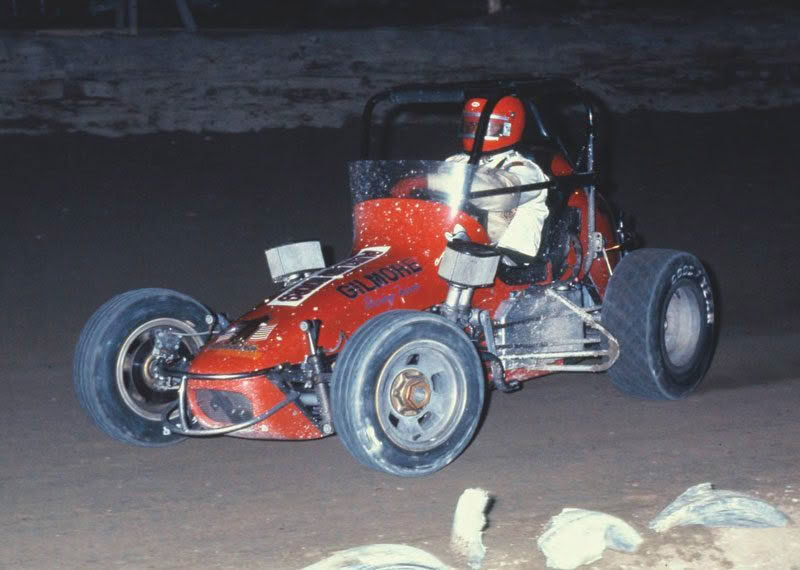
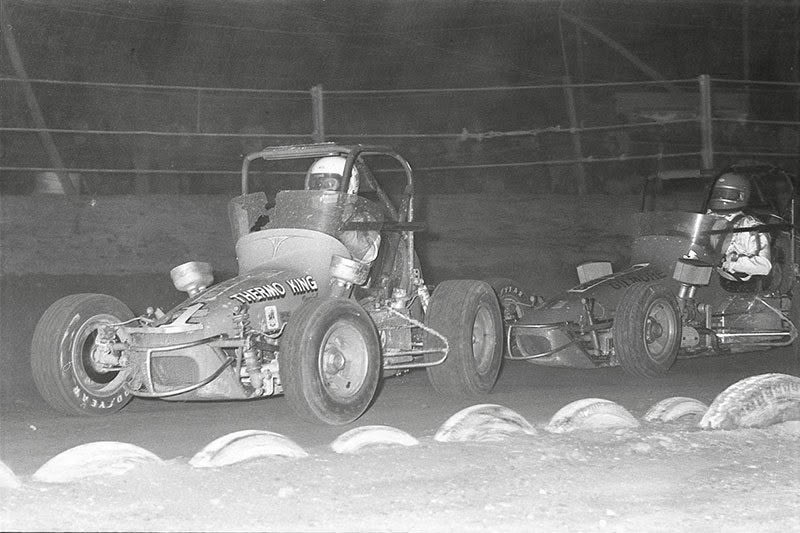
They aimed high but knew the untapped potential of the corporate world needed to be sold on Speedway racing but, based on what had been presented in previous years, knew it needed to be big.
With all due respect, drivers like Bob Tattersall, Merle Bettenhausen and Dave Strickland were big names in the Speedway world but were barely known in the outside world.
For many years the sport had piggybacked off the ‘Ronnie Moore-Barry Briggs-Ivan Mauger’ global domination of motorcycle speedway, and the likes of Barry Butterworth, Ian Holden and Trevor Morris were more likely to be on the tongues of the patrons at Ponsonby’s legendary ‘Gluepot’ than the Queen Street ivory towers, but Foyt was a global motorsport phenomenon.
Tervit, who was at the centre of the negotiations, knew he needed allies, and he used American Midgeteer Mel Kenyon, who had raced at the Springs several times to ‘open the door’.
When I spoke to George [Tervit] in 2017 about ‘the Foyt deal,’ it was clear that it was risky, expensive, and logistically challenging but worth taking.
“I took the possibility of luring Foyt to New Zealand and Australia to the annual Australasian Speedway Promoters Conference,” Tervit said. “When costings were discussed, all but Mike Raymond (promoter at Sydney’s Liverpool Speedway) considered it a ‘financially unviable’ proposition, so it was left to us to carry the can.”
A potential sticking point was that Foyt wasn’t prepared to drive a local car, so Mel Kenyon and his brother Don promised to assemble a brand spanking new machine for Foyt to use, and they would ship it down under from their Lebanon, Indiana headquarters.
At one point, news filtered through from the USA that Foyt may have changed his mind, but Raymond replied, “I don’t care what he costs. Our reputation as promoters is on the line. AJ will be racing in Australia this summer.”
And he did!
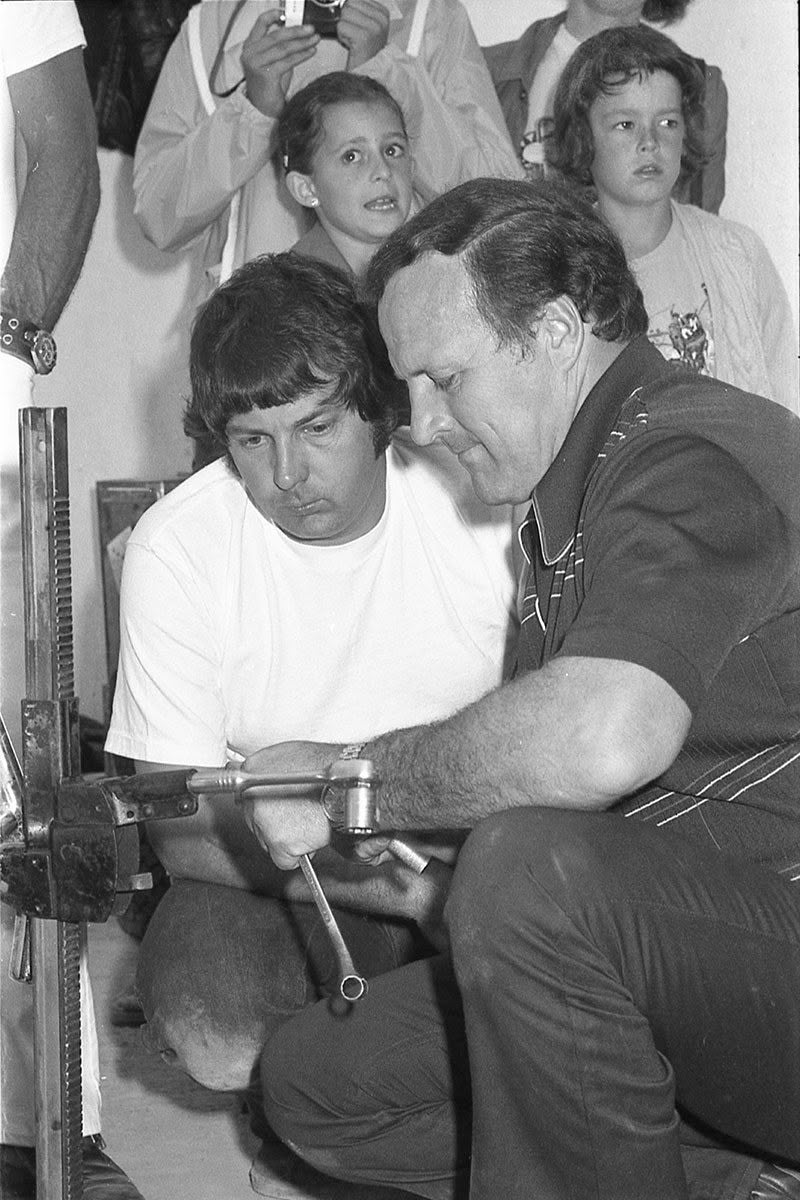
After much trepidation and more than a touch of anxiety, AJ Foyt - at that time a three-time Indianapolis 500 winner, Daytona 500 winner and a 24 Hours of Le Mans winner - arrived in New Zealand with his entourage which included his IndyCar sponsors Jim and Di Gilmore.
The country’s news media lauded the arrival of the motor racing great, but Foyt was more interested in getting out to Western Springs to run the car.
There was plenty of anticipation, but it was put on hold when heavy rain saw Foyt’s first appearance take a 24-hour rain check. Despite the sodden track and grounds, a big crowd poured through the gates to witness history in the making- one of the world’s true motorsport stars was racing Speedway in New Zealand.
It wasn’t a perfect start, with Foyt finishing third in a heat race and fourth in the Bob Tattersall Memorial. He told reporters after the race, “We will have to get the car right for Saturday. I’m not used to running fourth.”
Some social engagements were cancelled so that Foyt and his team could put in some hard yards, and they found a significant issue when they found that a lobe had broken off the cam. A big job faced them with another appearance at the Springs the next night, followed by a quick trip across the Tasman to race at Liverpool.
Tervit and co were undoubtedly getting desperate when their next race got washed out, so it was out to Auckland Airport early on Sunday morning, where they loaded the cars and personnel on a flight to Sydney to race later that day on the pavement at Liverpool.
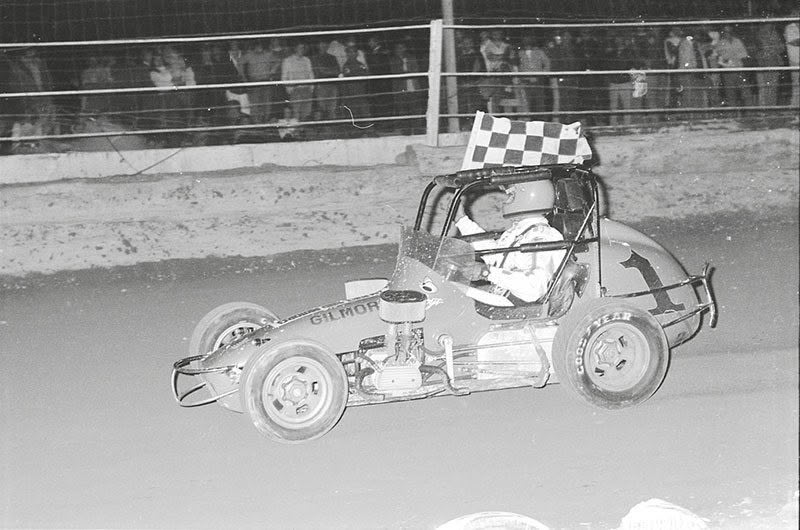
Mike Raymond remembered the chaotic schedule. “The first night at Western Springs (Wednesday) was washed out, so they raced Thursday. The Springs were supposed to run on the Saturday, but it rained again.
The cars were freighted across the Tasman to Liverpool to race Sunday, back to Auckland to race Monday and then down to Christchurch to race Tuesday.”
Added into the equation was that the car had to be reconfigured from dirt to pavement and back again.
Liverpool proved to be more up Foyt’s alley, and after finding some form in the heat races, Foyt and Kenyon started off the back row for the 40 Lap Australian Grand Prix. By the second lap, they were in the lead with Kenyon in front.
They were lapping the traffic by the seventh lap as they put on a real show. On the penultimate lap, Kenyon made the smallest of mistakes and clobbered the wall, putting Foyt into the lead and headed into victory lane.
There was little time for celebration and plenty of work to do in the next twenty hours. Kenyon’s car required straightening after he had hit the wall in the latter stages of the Liverpool race. There was also the small matter of the vehicles being cleaned before being flown back across the Tasman to Auckland for the rescheduled race.
Back at the Springs and AJ showed that he was ‘back in the seat’ as far as Midget car racing was going, following up on his Liverpool win by putting up a great display of racing in his opening race at the Springs, blasting from grid twelve to hit the front after only five laps, before taking the win over Australian Johnny Fenton with Kenyon third.
The feature event was the World 30 Lap Championship, and the two Americans had another back-of-the-field start.
It wasn’t long before they had carved their way through the traffic. Kenyon started to dominate as the laps went on, but the key battle was for the minor money where Australian Barry Pinchbeck, in an Offenhauser, and AJ were having a right royal go at each other. Every move by Foyt was countered by the Aussie, leaving AJ having to be content with third place, heading off Fenton and hometown heroes Trevor Morris and Barry Butterworth.
The following day, Australians Barry Pinchbeck and John Fenton joined Foyt and Kenyon on a trip south to race at Christchurch.
The hectic schedule began to take its toll on the travelling contingent, with most battling colds and tiredness. If ever tempers were going to fray, this was the night as AJ’s racing commitments in Australasia came to an end.
In some respects, it was also ‘save the worst for last’ and, although AJ’s only appearance in the South Island was one of historical significance, it was barely memorable for the quality of the racing. None of that can be laid at the feet of the drivers.
The quality of the drivers on hand deserved better, best summed up by AJ, who said, “I’ve raced on some slick tracks in my time but nothing as slick as this.”
Not only was the track hard and dry but there was an unhealthily thick coating of crusher dust, causing the cars to constantly wheel spin and go nowhere fast. Added to this was an electrical fault that invaded the starting lights and long delays in getting the fields lined up. It’s little wonder that there was a great relief to all that the tour was over– even if it took local officials until 11.30 PM to get the racing in.
AJ won one of the team races and then gathered up a couple of second placings before winning the feature race, which was shortened to just eight laps.
Foyt had to be back in the United States for tyre testing, and one can safely say that they all slept well on the plane trip home.
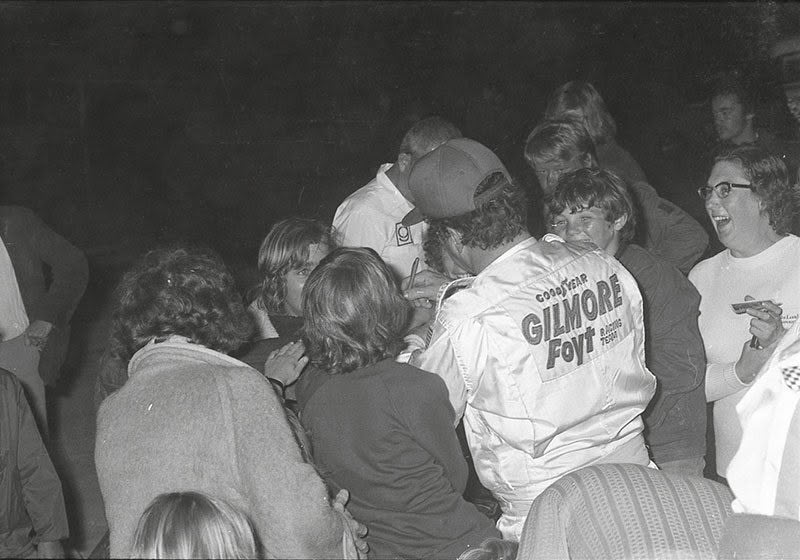
Despite the schedule, Foyt agreed to return ‘Down Under’ the following year if he could get a few days off to relax.
The tour would start this time in Australia, and Foyt travelled south with his good mate and fellow IndyCar legend George Snider who was travelling as ‘Car Owner’.
The rugged Texan again underlined his liking for the Liverpool pavement, carving up the field to win the Australian Grand Prix, lapping all but the second and third-place getters.
Foyt then made it two feature wins from two with another dominant performance on a trip up the road to race at the Brisbane Exhibition a couple of nights later.
There was a bit of breathing space with his first appearance at Western Springs for this campaign being four nights later, where he would be well tested by the formidable Kiwi contingent, as well as fellow Americans Mel Kenyon, Larry Rice and Gary Patterson and the highly rated Aussie pairing of Tony De Rosa and Johnny Fenton.
The night did not get off to a great start when, going into the first bend of a match race against Tony De Rosa and Kiwi Ted Tracey, all three cars locked together.
AJ’s VW spun onto the infield and sustained damage to the fuel injection unit. A rushed trip for a crew member to pick up a replacement unit and the subsequent repairs saw AJ sitting out of Race 2.
He re-joined the action for the third and final heat of the Champion of Champions series. From grid one, AJ was never headed. He certainly made up for lost time, knocking two seconds off Kenyon’s ten-lap record.
The final race of the night was the 20- lap Bob Tattersall Memorial. Foyt started off the back grid in fourteenth and, at the halfway mark, had made good progress and was making his way through traffic.
Suddenly a gap that had been opened closed, and AJ collided with local driver Dave Jolly, rolling three times as a result. His car came to rest minus a wheel, but that was small fry compared to Foyt, who emerged from the carnage shaken and stirred. The crash crew had to restrain him as he looked around for a chance to have a word with Jolly- and maybe settle the score.
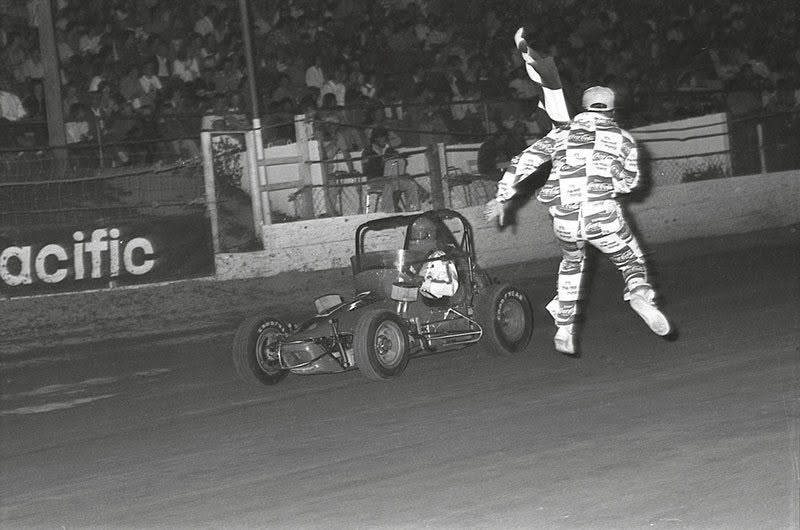
George Tervit remembered that despite Foyt’s ‘legendary’ temper, this was the only time that AJ nearly lost his cool on the two tours.
“AJ wasn’t at all happy. He certainly wasn’t used to getting put upside down.”
If there was one massive improvement on the previous tour, it was that the Foyt contingent had time to have a look around and have some fun.
Some of the pranks attained legendary status.
One involves AJ driving around Auckland at night, turning the ignition key on and off in his rental car to produce loud backfiring. Apparently, he couldn’t register how New Zealand appeared to close down at sunset.
The tour continued two nights later at the Te Marua Speedway near the nation’s capital, Wellington. The track was known more for its Stock Car racing, and it may have been the first time that AJ had raced at a track surrounded by logs as a safety fence.
A big crowd was on hand to witness the most significant ‘open wheel’ event in the track’s history, and there’s no doubt AJ would have been keen to get his tour back on track.
In his first race– a heat of the International Trophy Dash series- he won easily, heading Australian Tony De Rosa and Christchurch’s Laurie Millar home.
AJ’s lap time of 18.1 was a new record, but he blew that out the window when he won the Dash Final against Americans Gary Patterson and Mel Kenyon setting a new standard of 17 seconds flat.
He continued his winning ways by taking out the first heat of the Champion of Champions in a new ten-lap record time.
Fourth place was as good as it got in the second heat, but going into the final, he was just one point behind Kenyon. AJ was after another trophy and followed Australian Johnny Fenton through the traffic to sit in second by the end of the first lap. For nine laps, the order was Fenton, Foyt, Kenyon and Patterson, but on the last lap, Fenton drifted wide. AJ was through like a flash but was tagged by Patterson, who was hard on AJ’s tail. Foyt’s race was done, and he had to watch the finish from the infield.
The entourage was all set to fly back to Auckland the following day to race at Western Springs; however, with poor weather in the capital, the decision was made to drive.
This was the catalyst for a much talked about (in speedway circles) journey where a rental car was summonsed, and AJ drove Patterson and Rice back for the ten-hour trip…...it took six hours.
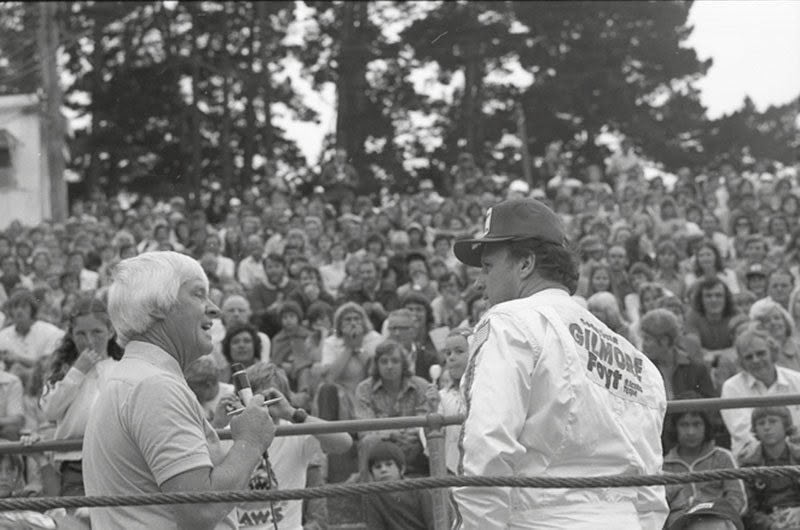
Whilst the fun-loving Patterson loved every second of the trip, Rice sat in the back seat with his eyes closed, convincing himself that the world’s most famous race car driver was at the wheel as the rental slid sideways around many corners on that long, twisting road.
The drive and its hair-raising moments were all for naught, with the Springs washed out the next two nights.
With poor weather on the horizon, a hastily arranged race at Palmerston North was organised. So, it was back down the island to Palmy, where another big crowd rolled through the turnstiles.
In association with George Tervit, Promoter Ray New had enticed Foyt, Mel Kenyon, Larry Rice, Gary Patterson and Aussies John Fenton and Tony De Rosa down to Palmerston North, and the racers responded with a great showing.
AJ bagged one win from the three races and left the crowd with no illusions about his legendary status.
He also weighed into a local issue when told that the speedway was under threat from noise complaints, telling a reporter from the Evening Standard that the ‘oval’ was one of the finest he had raced on.
“It’s ninety per cent better than all the quarter-mile tracks back home. It is something that the city really should be proud of!”
With that, it was back on the road to Auckland for the final race of his tour, but again rain intervened, and after two further rainouts, Foyt headed home, away from what was at that time Auckland’s wettest January since records had started in 1852.
It was a soggy end to what had been an amazingly brazen venture.
While it hadn’t provided a financial windfall at the ticket box for George Tervit and his partners Tony Leader and Gary Roberts, Tervit said the lift in profile for their track was a far greater return.
“It opened the corporate doors for us. Air New Zealand were so impressed that they agreed to fly drivers from the USA to New Zealand, along with their cars, for next to nothing, provided that driver had raced in the Indy 500.”
Another upshot is that many New Zealand and Australian race fans can say hand on heart that they had seen the legendary AJ Foyt racing in a Midget car.
Close on fifty years later, you have to respect the effort of promoters George Tervit, Gary Roberts and Tony Leader from Western Springs and Liverpool’s Mike Raymond, who collectively oversaw the mind-boggling logistical minefield in moving cars, drivers and crews from Auckland to Sydney, back to Auckland and then to Christchurch over the course of six days.
It’s little wonder that all these years later, they are still considered among the finest promoters the sport has seen.
Stephen Taylor stikes Ruapuna Gold
The action came fast and furious and left few doubting that the annual Gold Cup event at Ruapuna has become one of the country’s premier Sprintcar events.
Not only was racing from the top shelf, but Ruapuna’s desire to ‘put on a show’ was there for all to see with resident clown ‘Adam Allsorts’ entertaining the crowd, a moving ANZAC tribute, the walk around parade by the drivers with their cars, and plenty of fireworks- all complimenting the brilliant stadium sound system. The stage was set.
Amazingly, despite the previous night’s torrid action, only one car was missing: that of Corey McQuillan.
The Matt Honeywell team certainly put in the hard yards getting the Skyfarmers Aviators machine rebuilt after the previous night’s big crash. Another team that had burnt the midnight oil was Landon Dawson’s outfit, which had an engine shipped south from Nelson to transplant into the Stephen Taylor-driven car.
The cold conditions failed to deter a good-sized crowd from turning up for the final night of the season, which saw the continuation of the Ruapuna Rumble for Wingless Sprints as part of the ‘under card’.
With the previous night’s heat race points rolling over for the Gold Cup qualifying, there was always going to be some torrid action.
The first heat race showed that Allard was likely to continue the previous night’s domination as he raced through from grid seven to take an exciting heat win from Stephen Taylor, who had led for most of the race. Max Guilford grabbed third from promising Nelson driver Cambell McManaway, who didn’t look at all out of place in the strong field.
All hell broke loose in the next heat when a Lap 1 skirmish saw no fewer than six starters sidelined with both Nigel Colvin and Bailey Patterson rolling.
This cleared the way for Joel Myers Jnr to grab maximum points from Connor Rangi and perennial crowd favourite Jamie McDonald.
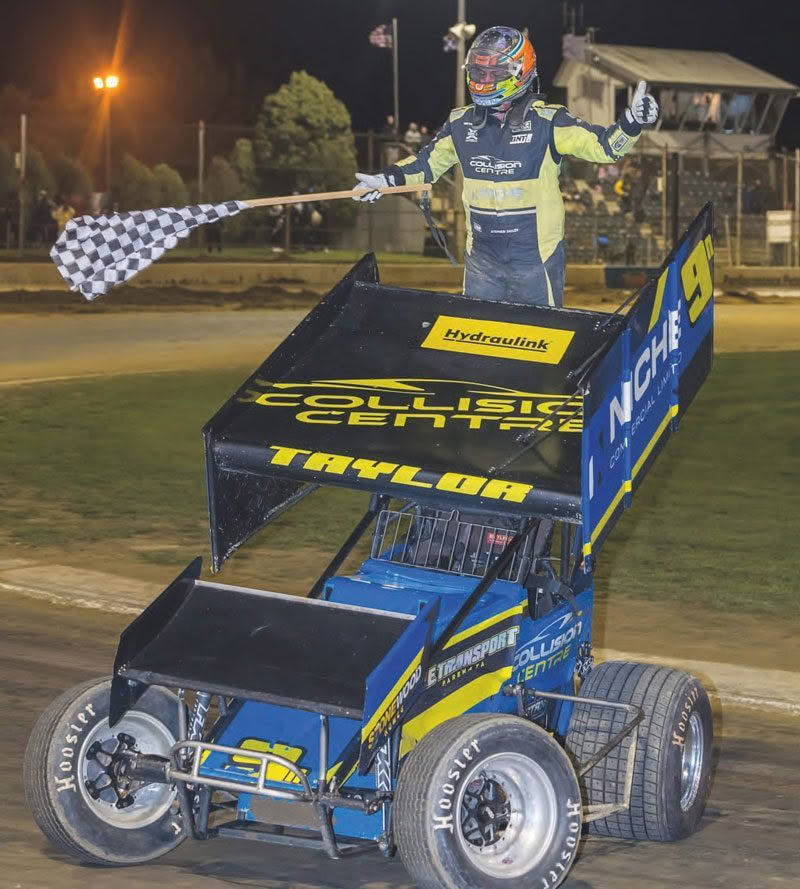
It was another Allard win in the third heat when he headed ‘The Sherriff’ Jayden Dodge across the line.
The final heat saw more carnage. Jamie Duff got his Gold Cup aspirations back in check with a great run, and he was leading by a handsome margin, but behind him, there was a real war being waged between Myers and Matt Leversedge. With a lap to go, the two got together as Myers made an inside pass, Leversedge’s car spearing into the fence, inflicting plenty of damage which would see his team having to dig deep to get the car ready for the feature.
Grid positions for the feature saw one through six determined by a pole shuffle. This came down to a ‘Shoot Out’ between top qualifier Allard, and Taylor who had moved up two spots from his original fourth spot. The American was in no mood to be upstaged, and despite Taylor’s efforts, it would be ‘JA’ who would pace the field for the 21st running of the storied Gold Cup event.
With the AC-DC hit ‘Thunderstruck’ blaring through the sound system, the big crowd applauded the drivers as they rolled into formation with the four-wide salute, and there was no shortage of expectation.
The Feature struggled to gain momentum with numerous early yellow lights, the first when Max Guilford spun out on the Prison Bend, forcing him to restart at the rear of the field.
Once the race settled down, Allard dominated until the 20th lap, when the American was going to put Gene Spooner a lap down but had been racing with no brakes for several laps, carrying too much pace and spinning out.
There was no hiding his disappointment as the Daltons ‘0’ was pushed to the infield. It was now game on for the Kiwis as Taylor had Rangi, Duff, McDonald, and Dodge snapping at his heels.
As the laps counted down Taylor took control, but Rangi was closing fast while Duff had to contend with McDonald. The hard-charging Guilford then worked his way into contention and was threatening to snatch a podium spot. In the last lap dash to the line, Taylor hung on to take the win from Rangi, with Duff, Guilford and McDonald rounding out the top five.
The key support racing came from the Wingless Sprints on the second night of their Ruapuna Rumble.
Invercargill’s Luke Shearing, who had been on top of the points after the first night’s racing, claimed the crown which was raced over two nights with each driver having six heat races.
Defending title holder Luke McClymont, from Bay Park, made up for a disappointing first night to finish second overall, redeeming himself with a strong night two performance, while Andrew Marker was third. McClymont and Marker were tied on points but McClymont’s faster lap time proved to be the tiebreaker.
The support class racing was also of a high standard. Veteran Midget car racer Glen Durie was the pick of the drivers in that class, placing in all three races, although he had to bow to Jeremy Webb in the feature.
Craig Cox and Jack Brownlees took out the Modified Sprint and Quarter Midget features respectively.
Allard wins 'The Goodie'
Iconic Californian Sprintcar racer Jonathan Allard showed what a class act he is when he dominated the recent ‘Salute to Goodie Classic’ at the Racecourse Hotel & Motorlodge Ruapuna Speedway.
The event, raced in the memory of Kiwi Speedway legend the late Noel Goodwin, saw the American back up his win last summer, leading home Auckland’s Max Guilford and local hero Jamie Duff.
Allard showed right from the first heat that he meant business with a dominant performance from near the back of the grid, carving his way through the field.
For much of that race, Max Guilford had led the way, but an official’s error saw the race go one extra lap, and it was on that lap that Allard hit the front. Allard then took out his next heat, making a stunning pass on an early race restart, blitzing past leader Jamie McDonald before building a commanding lead. McDonald hung onto second, fighting off a strong challenge from Wellington’s Stephen Taylor.
In his final heat, Allard stormed from the back of the field once again, surviving a big scare mid-race when he was forced to ‘ride the wall’ down the back straight with heavy traffic spread across the track in front. With local Matthew Leversedge leading the way, Allard had to dig deep to advance up the field, and he got by Guilford but was unable to peg back Leversedge who was a popular winner with the partisan crowd.
Other heat race winners were local’s Connor Rangi and Jayden Dodge, and American teenage sensation Joel Myers Jnr who had celebrated his 17th birthday a couple of days before the event.
Allard’s domination in the heats saw him starting off the front row for the feature, with Max Guilford sharing pacing duties after a fine run through the heats.
The crowd and drivers were well primed for the 25-lap race, but chaos broke out barely half a lap in the mid-field as Matt Honeywell rode the wheel, his car catapulting into a series of end-for-enders.
The Mid Canterbury veteran emerged from his heavily damaged car uninjured but facing a big job to get his car ready for the next night’s racing.
When the race resumed, Allard quickly took control while Guilford and Leversedge traded places a couple of times behind. Guilford broke clear, leaving Leversedge to fight off the rampaging American Myers, who eventually made the pass but was quickly picked off by local Jamie Duff.
With Allard continuing his run through the traffic, the chief interest in the last handful of laps was for the minor money.
Guilford was stuck in second and he almost succumbed to a challenge from the fast-finishing Duff, managing to hang on by a slender margin. Myers wasn’t done, however, and in the late stages he got past Duff, only to get out of shape and drop down the order.
Allard was his usual professional self in victory lane, praising not only the club for promoting such a great show, while commenting that the track was ‘about as good as it gets’, and then thanking the fans for rolling through the gates and supporting the Speedway, even in sub-tropical temperatures.
The night’s other main event was the first batch of heat races for the Wingless Sprints for the third annual Smith Racing Ruapuna Rumble. The drivers responded with 27 entries, producing plenty of hectic wheel-to-wheel racing.
The six heat races saw the honours evenly shared with five different winners. Cromwell’s Brian Ellison was the only driver to take two wins.
Other drivers to claim the chequered flag were Jake Shearing, Laurie Petersen, Kirk Hawkins and Blair Smith. Consistent placings over the night saw Invercargill’s Luke Shearing sitting at the top of the points standings with 56 points, two clear of Hawkins, with Harrison Brown, Ellison and Andrew Marker all locked together in third place on 53.
Defending champion Luke McClymont, who was chasing a third consecutive ‘Rumble’ title, had an indifferent first night and was back in eighth place, needing to get on top of some mechanical issues to become a threat in the next round.
The TQs also had their final outing for the season, and they turned on their usual highly competitive wheel-to-wheel action.
Rookie Ethan Smith and Ben Morgan took out heat wins, while Tyler Warnock won the feature from Kimberley Yeatman with Aaron Findlay.
Harry McIntyre continued his late-season form to take a heat and the Modified Sprint feature, while Courtney Jones won the other heat race.

